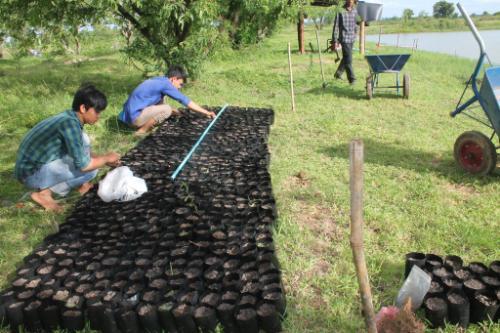Project in Cambodia
Living Fences for Improved Livestock Feed in Cambodian Smallholder Systems
Timeframe: June 2017 - September 2019
Funding: USAID
Principal investigator (PI) and lead institution
Tom Gill, University of Tennessee
Co-PI and collaborator institutions
- University of Tennessee: David Ader, Amanda Kaeser, Jason Smith
- Lyda Hok, Royal University of Agriculture
- Srean Pao, University of Battambang
Results
- Gill, T., Ader, D., Srean, P., Hok, L., Cheat, S. and Lear, A. 2020. Living fences for improved smallholder livestock systems in Cambodia. Forests, Trees and Livelihoods. https://doi.org/10.1080/14728028.2020.1827049
- Innovation Summary. June 2020. Leucaena Leucocephala Tree Species for Living Fences and Animal Feed in Cambodia
- Case Study. 2019. Cattle management with living fences in Anlong Thmey, Battambang, Cambodia
Project Plan

In the rice-based systems of northwest Cambodia, the majority (50-70%) of these smallholder households own livestock, particularly cattle and buffalo. These livestock are typically restricted to foraging and grazing on rice stubble and straw, especially in the wet season, and supplemented by small quantities of fodder of native grasses, which are collected at roadsides or in paddies in both wet and dry seasons. In addition, smallholders face multiple challenges to maximize efficiencies in terms of sustainably intensifying their production systems, for both animals and crops. One of these challenges—the regular hunger seasons that smallholders face—results in little consistency in high-quality livestock feed supply throughout the year, which is a major constraint to livestock performance. Another critical challenge—livestock roaming in the dry season for forage—results in smallholders having few options to protect any post-rice dry season crops from free range animals.
Our approach involved the rigorous evaluation of three nutritious living fence species (Gliricidia sepium, Leucaena leucocephela, and Moringa oleifera)for their potential as supplemental livestock and human nutrition and also as effective protection from wandering livestock. We focused on capacity building of the Center of Excellence for Sustainable Agricultural Intensification and Nutrition, housed under the Royal University of Agriculture, as a key vehicle for sustainability of agricultural development efforts in Cambodia under U.S. government assistance. Our impact will be a rapid evaluation of the potential of living fences as a viable additional livelihood strategy option to enhance smallholder livestock systems in Cambodia.
The overall goal of this project was to examine the production of tree species as living fences for added nutrition and crop protection for Cambodian smallholder livestock systems. Specific project objectives include:
- Evaluate living fence species using on-station livestock feeding trials;
- Improve capacities of farmers to produce and manage living fences;
- Evaluate constraints and impacts of using living fences on farms, through household surveys and focus groups; and
- Evaluate the potential to use living fences to protectfood crop and fodder plots on-station.
More Information
-69x52.png) October 2020 research update GILL VGM (Virtual General Meeting)
October 2020 research update GILL VGM (Virtual General Meeting)
- Project factsheet
- What are Living Fences?
- Cattle management with living fences in Anlong Thmey, Battambang, Cambodia: Cattle management with living fences in Anlong Thmey, Battambang, Cambodia
- Examples of Living Fences in Cambodia (note)
- How to Establish a Living Fence (note)
Photo credit: D. Ader
Feed the Future Innovation Lab for Livestock Systems is part of Feed the Future





